


What is Dr. Morepen Forever Young?
Dr. Morepen Forever Young is a safe ayurvedic medicine for men. Recommended by Ayurvedic experts, Forever Young is a balanced combination of powerful ayurvedic herbs and minerals that
It is a 100% natural medicine, without any steroids, to cure sexual dysfunctions in men like ED (Erectile Dysfunction), Premature Ejaculation, Infertility, Low Sperm Count, etc. Forever Young has been made by 21 powerful herbs & minerals that help to combat fatigue and all the other problems mentioned above.
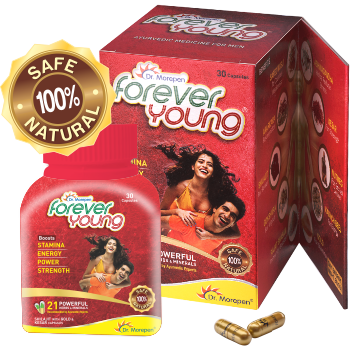

Bhasmas are fine powdered Ayurvedic preparations which are made from pure metals or minerals. Healing with the help of minerals like gold, silver is one of the ancient therapies which are used in various health problems. Swarna Bhasma (Gold) may occur as deposits with lodes or veins (between the layers) in fractured rock. Most deposits form when heated fluids circulated through gold-bearing rocks, picking up gold and concentrating it in new locations in the crust (hardened outer layer of rock). Swarna bhasma is one of the ancient powdered Ayurvedic preparation prepared by using pure gold. It is being used to treat different health problems like respiratory problems, heart problems & infertility, etc.
Read more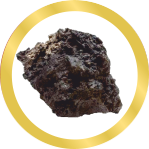
Shilajit or Shilajeet is probably the only natural herb which can be used to cure multiple health issues altogether. That’s why it is called ayurveda’s only panacea (a remedy used to provide cure-all). Shilajit is a rock-tar found in Himalayas, with a color ranging from white to dark brown. This rock is formed after years of decomposition of organic material (plants and animals). When the summer season is at its scorchingly best, Shilajit exudes out of Himalayas. It contains 85 minerals in ionic form, as well as triterpenes, humic acid & fulvic acid. Because of the wide range of benefits Shilajit possesses, it is also considered as India’s most valuable herbal remedy.
Read more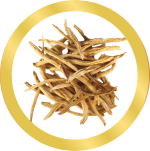
Safed musli (Chlorophytum borivilianum) is one of the most valued herbs from India. It is a herb from tropical wet forests in India (in Kerala, Karnatka). It is cultivated and eaten as a leaf vegetable in some parts of India, and its roots are used as a health tonic. Safed musli is being used in traditional systems of medicine like Ayurveda. Safed musli contains many chemicals in our body that have testosterone and anti-inflammation like effects.
Read more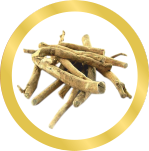
Ashwagandha is a plant in the Solanaceae or nightshade family. It is cultivated in many of the drier regions of India, like Punjab, Madhya Pradesh, Haryana, Uttar Pradesh. The species name somnifera means “sleep-inducing”. The name, ashwagandha, is a combination of the word ‘ashva’, meaning horse, & gandha, meaning smell, reflecting that the root has a strong horse-like odor.
Read more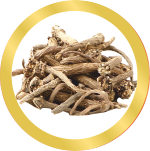
Akarkara (Anacyclus pyrethrum) is cultivated in Himalayas and other northern parts of India. This plant mostly known for its aphrodisiac effect on the body and is used in the form of dried powder. Extracts of akarkara have anabolic activity and also increase testosterone in men.
Read more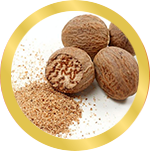
In India, it is mainly cultivated in Kerala, Tamil Nadu and Karnataka. Nutmeg is mentioned in ‘Bhavprakash Nighantu’, an ancient vocabulary of medication for its aphrodisiac, anti-inflammatory and stress relieving properties.
Read more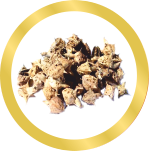
Gokshura (Tribulus terrestris) is an annual plant widely distributed around the world, that is adapted to grow in dry climate locations in which few other plants can survive. Gokshura is native to warm temperate regions in southern Europe, southern Asia, throughout Africa and Australia. In India, it is found mainly in Rajasthan, Uttar Pradesh, Bihar and Assam. In Ayurvedic pharmacology, gokshura is used as a powder form of its plant, particularly the fruits, and it is known in Sanskrit as gokshura, meaning the "cow's hoof", possibly because the small thorns tend to get stuck on grazing animals. Gokshura is believed to improve overall general and sexual health among men.
Read more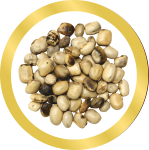
Kaunch beej (Mucuna pruriens) is one of the popular herbs used for medicine purpose across the world. This plant is native to Africa and tropical Asia and widely naturalized and cultivated. In India, it is grown mostly in central and southern states. The seeds of Kaunch beej have been used for treating many dysfunctions including in Unani and Ayurvedic medicine.
Read more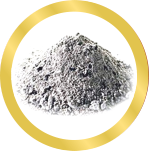
Rajat bhasma is an Ayurvedic medicine prepared from silver. Silver has long been valued as a precious metal. The metal is found in Earth’s crust in the pure, free elemental form. Rajat bhasma is the powdered form of silver metal. Rajat bhasma is an astringent and bitter-sweet in taste. Also, it is a natural coolant. According to Ayurveda, it is a very useful natural supplement and without any known side effects.
Read more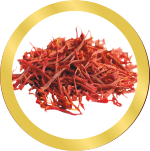
It is a spice derived from a flower called ‘saffron crocus’. In India, this plant is mainly cultivated in Jammu & Kashmir and Himachal Pradesh. Dried saffron is composed of carbohydrates (65%), fat (6%), protein (11%) and water (12%). In comparison to other spices and foods, the nutrient content of dried saffron shows richness in content of B vitamins and dietary minerals, like calcium, iron, and phosphorus.
Read more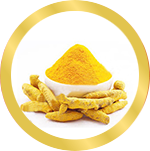
Haldi (Curcuma longa) is a flowering plant from ginger family. It is native to the Indian subcontinent and Southeast Asia, and requires temperatures between 20 and 30 °C (68 and 86 °F) and a considerable amount of annual rainfall to thrive. Haldi has been used since ancient times for various marriage rituals and also by our traditional medicine system as a natural remedy for reducing inflammation.
Read more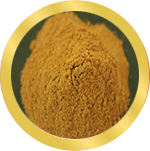
Varahikand (Dioscorea bulbifera) is a plant from the yam family. It is also known as Air Potato. This plant is native to Africa, Asia and northern Australia. It is widely cultivated and has become naturalized in many regions of India, including Gujarat, Assam, and Tamil Nadu. Varahikand is an excellent aphrodisiac and has been used by Ayurveda for many conditions such as diabetes, and skin ailments.
Read more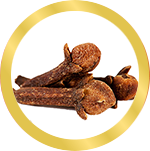
Lavang is the aromatic flower bud of a tree in the family Syzygium aromaticum. It is native to Indonesia, India, Pakistan, Bangladesh, and Sri Lanka. Cloves are used in Indian Ayurvedic medicine, Chinese medicine, and western herbalism and dentistry where the essential oil is used as a painkiller for dental emergencies.
Read more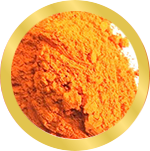
Vidarikand (Pueraria tuberosa) is a climber with woody stem. It is a climbing, coiling and trailing vine with large tuberous roots. It is native to India, Pakistan, and Nepal. Vidarikand’s medicinal potency is because of its Himalayan origin. It is mainly used to rejuvenate the reproductive system and is a tonic. It enhances sexual desire, treats nocturnal emission in men. It is an aphrodisiac and a cardio-tonic.
Read more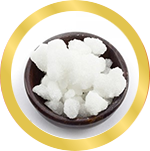
Camphor is a waxy, flammable, transparent solid with a strong aroma. It is found in the wood of the camphor laurel (Cinnamomum camphora), a large evergreen tree found in Asia. Camphor has been used in traditional medicine from time immemorial in countries where it was native. It was probably the odor of the substance and its decongestant (relieving congestion) effect that led to its use in medicine.
Read more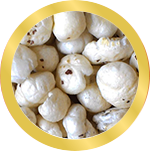
Makhana is the seed of a plant in the genus Nelumbo, particularly the species Nelumbo nucifera. The seeds are used in traditional medicine. Mostly sold in dried, shelled form, the seeds contain rich contents of protein, B vitamins and dietary minerals.
Read more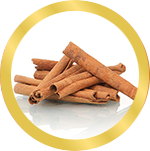
Cinnamon is a spice obtained from the inner bark of several tree species from the genus Cinnamomum. Cinnamon is an evergreen tree characterized by oval-shaped leaves, thick bark, and a berry fruit.
It is a native of Sri Lanka. In India this spice is cultivated in Kerala and Tamil Nadu.
The constituents of this herb include some 80 aromatic compounds, including eugenol found in the oil from leaves or bark of cinnamon trees.
Cinnamon has a long history of use in traditional medicine. It has been tested on a variety of clinical conditions, such as bronchitis or diabetes.
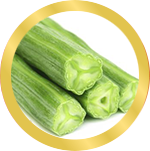
Sahijan (Moringa oleifera) is the most widely cultivated species in the genus Moringa. Common names include moringa, drumstick tree (from the long, slender, triangular seed-pods), and horseradish tree (from the taste of the roots, which resembles horseradish). Sahijan is a fast-growing, drought-resistant tree, native to the southern foothills of the Western Ghats in southwestern India. Moringa has been used for centuries due to its medicinal properties and health benefits.
Read more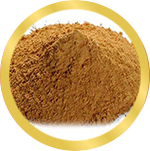
Yashad bhasma is an Ayurvedic powdered form of specially processed zinc. Zinc deficiency is responsible for impaired glucose metabolism, retarded growth and weakness of eyesight. Intake of Yashad Bhasma cures Zinc deficiency and thus improves body immunity to fight infections. Zinc improves reproductive functions and supports formation of new blood.
Read more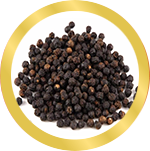
Black pepper (Piper nigrum) is a flowering vine in the family Piperaceae, cultivated for its fruit, which is usually dried and used as a spice and seasoning, known as a peppercorn. Black pepper is native to Kerala in Southwestern India and is extensively cultivated there. Kali Mirch has been used since ancient times both for its flavour and as a traditional medicine. Black pepper is the world's most traded spice.
Read more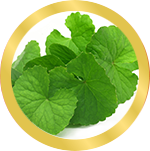
Brahmi (Bacopa monnieri) is a perennial, creeping herb native to the wetlands of Southern and Eastern India, Australia, Europe, Africa, Asia, and North and South America.
Read more